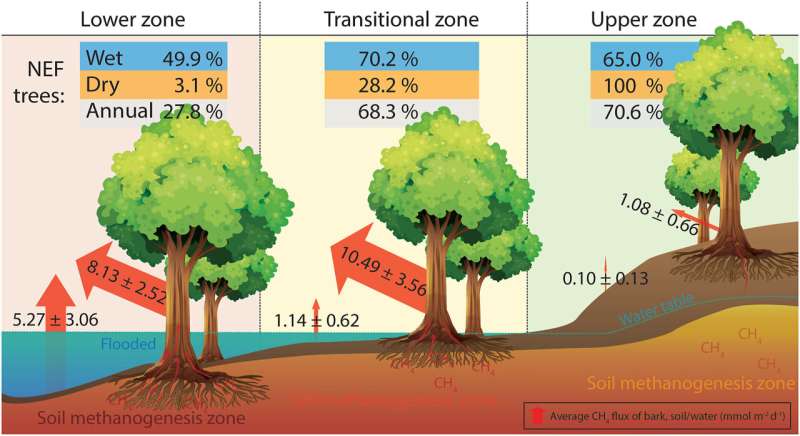This article has been reviewed according to Science X's editorial process and policies. Editors have highlighted the following attributes while ensuring the content's credibility:
fact-checked
trusted source
proofread
Study tracks how wetland tree stem emissions vary by season, location, and hydrological conditions

The recent rise in atmospheric methane (CH4) has drawn increased attention to the potent greenhouse gas, which is approximately 45 times more powerful than carbon dioxide at trapping heat in the atmosphere. About 60% of global methane emissions are anthropogenic, primarily from fossil fuel burning and other activities in the transportation and agriculture sectors. The remainder of the methane budget comes from natural ecosystem processes.
Tropical wetlands are the largest natural source of methane, but estimates of their emissions are uncertain. One reason for this uncertainty may be the poorly constrained contributions of tree stems, or trunks, which were coined the "new frontier in the global carbon cycle" in a recent paper. Various processes drive tree stem emissions, including microbial production in wet or rotting heartwood, saprotrophic fungi, and soil methane transported and emitted through plant tissues.
A team led by Jeffrey quantified annual and seasonal changes to tree stem methane emissions in an Australian subtropical forested wetland dominated by broad-leaved paperbark (Melaleuca quinquenervia). This is the first study to monitor wetland tree stem emissions over the course of a year. The study has been published in the Journal of Geophysical Research: Biogeosciences.
At the study site in New South Wales, Australia, the authors delineated three sampling zones along a hydrological and topographic gradient, stretching from a lowland wetland forest dominated by paperbark to an upland zone characterized by mixed forest and grasses. They sampled 10 trees of varying diameters in each zone, taking stem measurements at four heights and then repeating the process over eight campaigns. For comparison, they simultaneously sampled the adjacent soil and aquatic methane fluxes.
The results showed that tree stem methane emissions varied significantly between trees, sample heights, hydrological conditions, topography, and seasons: Among the trees sampled, emissions spanned six orders of magnitude.
Changes in water table height drove the variation, with trees emitting the most methane under the wettest conditions. Overall, the authors estimated that tree stems contributed 28%–68% of the annual methane emissions from the wetland forest, representing a significant, rarely quantified emission pathway.
The authors emphasize the need for future research into tree stem emissions, particularly in tropical and subtropical ecosystems that remain underrepresented compared with sites at higher latitudes. Further diversifying study locations and characterizing seasonal changes in methane emissions will improve global methane budgets that contribute to our understanding of a changing climate.
More information: L. C. Jeffrey et al, Large Methane Emissions From Tree Stems Complicate the Wetland Methane Budget, Journal of Geophysical Research: Biogeosciences (2023). DOI: 10.1029/2023JG007679
Provided by American Geophysical Union
This story is republished courtesy of Eos, hosted by the American Geophysical Union. Read the original storyhere.




















